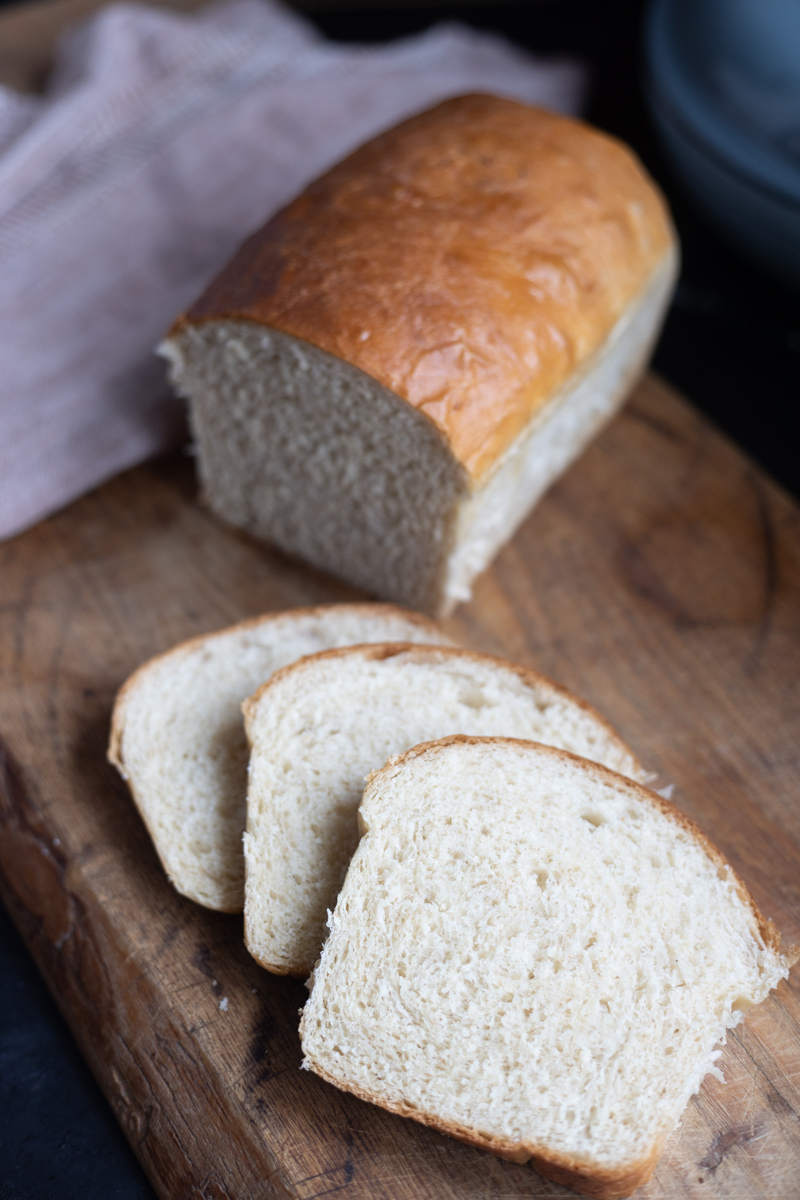INSTANT YEAST: It's not necessary to "proof" instant yeast or allow the dough to rise before shaping, so the process is much quicker.
Warm water and milk to about 100F in the microwave or on the stovetop. The liquid must NOT be any warmer than 110F, or it will kill the yeast. Add warm milk and water, sugar, olive oil, salt, and instant yeast to a large mixing bowl or the bowl of a stand mixer with the dough hook attachment and mix to combine. Add 4 cups of flour and mix, slowly add another 1/2 cup of flour at a time until the dough comes together into a ball that is still slightly sticky, but workable.
If using a bowl and hand kneading, turn the dough out onto a lightly floured surface and knead for 5 minutes until the dough is smooth. If using a stand mixer, knead with the dough hook on medium speed for 3-5 minutes. The dough should be slightly sticky, but easy to handle.
Divide the dough in half, each half should weigh about 700g. Shape each half into a loaf shape and place the seam side down into greased loaf pans. Cover the pans with a damp towel and place them in a warm spot. The dough rise should take an hour or two. Once it has doubled in size to fill out the loaf pan and risen to about a half inch above the top of the pan, it is ready to bake.
Gently brush the tops of the loaves with melted butter and bake at 350F for 30 minutes. The tops of the loaves will be golden brown when they come out of the oven, brush the tops with melted butter again and let the loaves rest in the loaf pans for 5 minutes before turning them out to cool.
Turn the loaves out to cool on a wire rack for 30-60 minutes before slicing. This resting period is important because the bread continues to bake in the center so long as the loaf remains whole. Don't worry, it will still be warm after a short rest period if you're wanting a slice of warm butter bread!
ACTIVE DRY YEAST: Active dry yeast must proof and requires a first and second rise, so the rise time is longer than if using instant yeast.
Warm water and milk to about 100°F in the microwave or on the stovetop. The liquid must NOT be any warmer than 110°F, or it will kill the yeast. Pour the warm milk, water, sugar, and yeast into a bowl, cover it with a towel, and let it proof for 10-15 minutes or until the yeast is foamy.
Add the olive oil, salt, and 4 cups of flour to the yeast mixture. Mix and slowly add another 1½ cup of flour at a time until the dough comes together into a ball that is still slightly sticky, but workable.
If using a bowl and hand kneading, turn the dough out onto a lightly floured surface and knead for 5 minutes until the dough is smooth. If using a stand mixer, knead with the dough hook on medium speed for 3-5 minutes. The dough should be slightly sticky, but easy to handle.
Shape the bread dough into a ball and place it back in a greased bowl, cover with a damp towel, and begin the first rise. To speed up this process, place the bowl in a warm place like the oven on proof setting (anywhere from 100-110F) or a proofing box. Otherwise, just let it rise at room temperature.
Once the dough has doubled in size, punch it down, turn it out onto a floured surface, and knead for a minute until smooth. Divide the dough in half, each half should weigh about 700g.
Knead each half of the dough for a moment and shape into a ball, place seam side down on the counter, cover with a towel, and let the dough rest for 15 minutes.
Shape each half into a loaf shape and place the seam side down into greased loaf pans. Cover the pans with a damp towel and place them in a warm spot for the second rise. The dough rise should take an hour or two. Once it has doubled in size to fill out the loaf pan and risen to about a half inch above the top of the pan, it is ready to bake.
Gently brush the tops of the loaves with melted butter and bake at 350 degrees F for 30 minutes. The tops of the loaves will be golden brown when they come out of the oven, brush the tops with melted butter again and let the loaves rest in the loaf pans for 5 minutes before turning them out to cool.
Turn the loaves out to cool on a wire rack for 30-60 minutes before slicing. This resting period is important because the bread continues to bake in the center so long as the loaf remains whole. Don't worry, it will still be warm after a short rest period if you're wanting a slice of warm butter bread!
